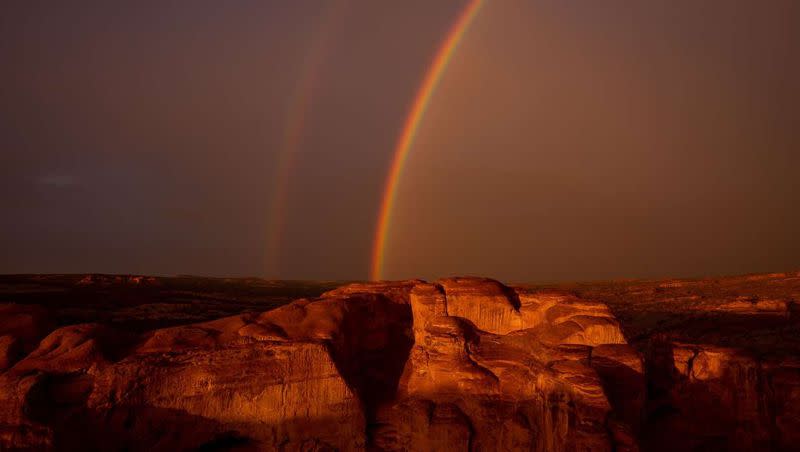Why this online travel guide ranks Utah's 'Mighty 5' poorly among 63 national parks

Are Utah's "Mighty 5" national parks too popular to be considered the best?
That's essentially the argument that an online U.S. travel guide makes in its attempt to rank the country's 63 national parks as a way to celebrate National Park Week, which wraps up Sunday. Travel Lemming pieced together a ranking of the parks based on national park visitation data and online reviews placed on Google, TripAdvisor and Yelp.
The staff also took into account the weather (using climate data to determine areas that average between 50 and 90 degrees), the average price of hotels near a park, how easy it is to get to the park through transportation, and even the biodiversity of a park, which is determined by the by various species that live in a park.
No Utah park cracked the top 10 — or even the top 15, for that matter — when the team tabulated the formula. Here's how Utah parks fared:
Capitol Reef: 18th
Zion: 26th
Canyonlands: 32nd
Arches: 50th
Bryce Canyon: 58th
So what hurt Utah parks in the rankings? Crowding seems to be the largest factor.
For example, the outlet notes that Zion National Park — the third-most visited national park, with nearly 4.7 million visitors last year — landed as the ninth-most crowded park with nearly 32 visits per acre. Bryce Canyon placed seventh in crowding, while Arches ended up 11th in that category.
This essentially offsets how well all of the parks succeeded in online reviews. Bryce Canyon tied Acadia, Badlands, Glacier Bay, Grand Teton, Great Smoky Mountains, Kenai Fjords and Mount Rainier for the highest average online review at 4.97 out of 5 stars. Arches finished right behind with an average of 4.93 stars, while Canyonlands, Capitol Reef and Zion national parks all tied for 19th at 4.77 stars.
Other variables got in the way. Zion National Park had the 23rd best accessibility score, the highest among the "Mighty 5." It also had the highest biodiversity rating at No. 26 in that category. Southeast Utah's parks, and their iconic geology, didn't fare well in this category.
Arches, Canyonlands and Zion struggled because of low affordability scores, while Bryce Canyon also slipped because it was rated as having the 17th worst weather.
When taking all six of these categories into account, Travel Lemming declared Virginia's Shenandoah as the nation's best national park. It won as it placed in the top 10 for affordability, accessibility and biodiversity, while also ranking fairly high in reviews and weather.
North Cascades (Washington), Biscayne (Florida), Kings Canyon and Sequoia (both in California) national parks rounded out the top five. Meanwhile, Kobuk Valley National Park in Alaska ended up last on the list. While it's the fifth-least crowded park, it landed near the bottom in reviews, weather, biodiversity and accessibility.
McKenna Mobley, a senior travel writer for the outlet, explained Thursday that the list isn't meant to roast any park. She insists that it may offer a wider scope than just what people review online.
"I hope this report highlights the fact that some of America's less famous parks offer far more than what meets the eye," she wrote in a news release. "Sometimes the best experiences can be found at hidden park gems that are off the lemming path."
This follows some of what Utah tourism leaders have done in recent years, pointing visitors toward the state's state parks and national monuments to spread out crowds while also getting people to appreciate all that the state has to offer. The record crowding in 2021 also dimensioned some last year, as the "Mighty 5" experienced a nearly 7% decrease in visitation, bringing in a little more than 10.5 million visitors combined.
Utah wasn't singled out by Travel Lemming either. Several other well-revered national parks also fell below what one would suspect. Great Smoky Mountains National Park, located between Tennessee and North Carolina and ranks as the most visited national park every year, ended up 11th in this report's rankings, mainly because it had top reviews and biodiversity rankings.
Grand Canyon National Park ended up 15th, while Yellowstone National Park placed 23rd and Yosemite National Park landed in the No. 34 spot on the outlet's list.
Travel Lemming staff said Thursday they plan to update the list in the future, especially as its key formula factors change. But even they admit that it's difficult to rank parks when they all bring something unique that visitors find special.
"Every U.S. national park offers its own special flair," Mobley said. "So, in some sense, ranking them is like ranking music genres — they're all good."

